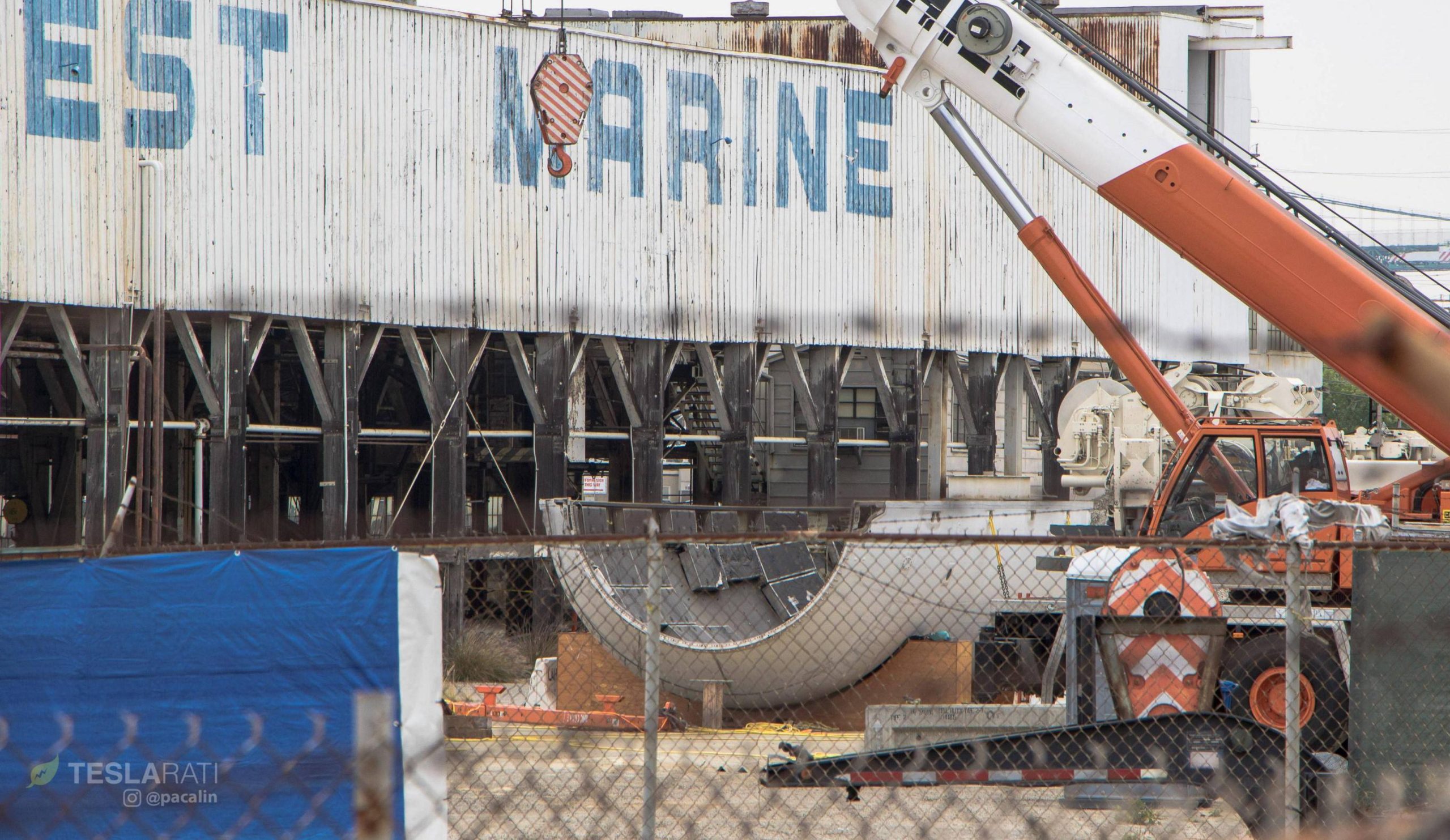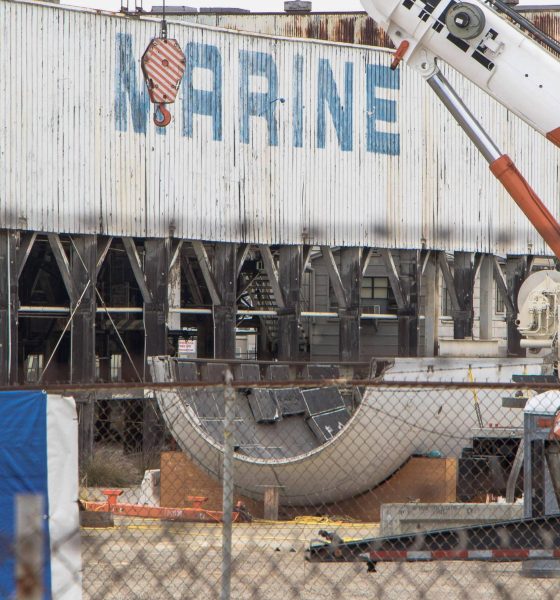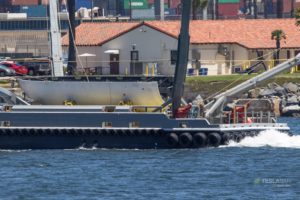

News
SpaceX ramps BFR factory construction as Mr Steven arm surgery continues
Photos taken on July 1st show that land leased by SpaceX to build the first port-located BFR factory and Falcon 9 refurbishment center is continuing to ramp initial construction work, ranging from general clean-up of the long-abandoned berth to serious foundation preparation where SpaceX’s new rocket warehouse will be built.
Previously a shipyard, the Berth 240 facility now leased by SpaceX sat abandoned for the better part of a decade, and features a number of buildings deemed historic landmarks by the city of Los Angeles. As the new tenant, SpaceX is expected to do at least a little refurbishment, with the goal of leaving the site in better shape than they found it in at the end of their 10-year lease. The company does have permission, nonetheless, to demolish one less historic building in order to make space for their planned BFR factory, the construction of which is expected to take 12-18 months for Phase 1 and another 12 or so months for Phase 2, meshing nicely with SpaceX real estate director Bruce McHugh’s estimate of “three to five years” to completion.
On the rocket recovery fleet side of things, SpaceX’s fairing-catcher Mr Steven is still stationed at Berth 240 with all major components of his previous arm assembly now fully removed and stored nearby on the dock. In June 2018, CEO Elon Musk noted on Twitter that the iconic vessel was to have its net grown by a factor of four, meaning that both its length and width would be roughly doubled.

SpaceX’s Berth 240 prospective BFR factory is chock-full of construction equipment. (Pauline Acalin)
Sitting around 400 square meters before arm removal, the new net would be closer to 1500 square meters – roughly 1.5 acres – and could nearly halve the accuracy gap that the company’s engineers need to close in order to reliably catch Falcon payload fairings, cutting 20-30 meters out of the 50 meters most separating the fairing and net at touchdown. Once SpaceX is able to close that gap and start catching fairings before they hit seawater, it should be a fairly simple process to start routinely reusing both halves of the $3 million carbon composite-aluminum honeycomb shells.
Unless they can be rapidly cycled out of the net after landing, recovering both halves may require a second net vessel like Mr Steven, and there could wind up being as many as four Mr Steven copies if the company intends to recovery both fairing halves after every launch from both their California and Florida launch pads. Recent planning on the Florida coast indicates that SpaceX expects their launch cadence to ramp up considerably with the introduction of a fleet of highly-reusable Falcon 9 Block 5 boosters, and the considerable lead-time and sluggishness inherent to manufacturing massive aerospace-grade composite structures with equally vast autoclave ovens means that payload fairings could quite quickly become a bottleneck for SpaceX’s launch business.
- SpaceX’s BFR tent and mandrel, caught on April 14th. (Pauline Acalin)
- Mr Steven out and about with a recovered but unreusable fairing half in May 2018, presumably for some sort of practice. (Pauline Acalin)
While such a bottleneck is far from insurmountable, dramatically expanding Falcon 9 composite component production now would presumably be an inconvenience for SpaceX at a time where they would much rather be focusing internal investments on their next-generation launch vehicle, known as BFR. That rocket is understood to be in the late stages of design and is quickly entering into a more advanced stage of concerted full-scale prototype testing and refinement as SpaceX accumulates invaluable data from hands-on R&D.
Follow us for live updates, peeks behind the scenes, and photos from Teslarati’s East and West Coast photographers.
Teslarati – Instagram – Twitter
Tom Cross – Twitter
Pauline Acalin – Twitter
Eric Ralph – Twitter

News
Nvidia CEO Jensen Huang explains difference between Tesla FSD and Alpamayo
“Tesla’s FSD stack is completely world-class,” the Nvidia CEO said.

NVIDIA CEO Jensen Huang has offered high praise for Tesla’s Full Self-Driving (FSD) system during a Q&A at CES 2026, calling it “world-class” and “state-of-the-art” in design, training, and performance.
More importantly, he also shared some insights about the key differences between FSD and Nvidia’s recently announced Alpamayo system.
Jensen Huang’s praise for Tesla FSD
Nvidia made headlines at CES following its announcement of Alpamayo, which uses artificial intelligence to accelerate the development of autonomous driving solutions. Due to its focus on AI, many started speculating that Alpamayo would be a direct rival to FSD. This was somewhat addressed by Elon Musk, who predicted that “they will find that it’s easy to get to 99% and then super hard to solve the long tail of the distribution.”
During his Q&A, Nvidia CEO Jensen Huang was asked about the difference between FSD and Alpamayo. His response was extensive:
“Tesla’s FSD stack is completely world-class. They’ve been working on it for quite some time. It’s world-class not only in the number of miles it’s accumulated, but in the way it’s designed, the way they do training, data collection, curation, synthetic data generation, and all of their simulation technologies.
“Of course, the latest generation is end-to-end Full Self-Driving—meaning it’s one large model trained end to end. And so… Elon’s AD system is, in every way, 100% state-of-the-art. I’m really quite impressed by the technology. I have it, and I drive it in our house, and it works incredibly well,” the Nvidia CEO said.
Nvidia’s platform approach vs Tesla’s integration
Huang also stated that Nvidia’s Alpamayo system was built around a fundamentally different philosophy from Tesla’s. Rather than developing self-driving cars itself, Nvidia supplies the full autonomous technology stack for other companies to use.
“Nvidia doesn’t build self-driving cars. We build the full stack so others can,” Huang said, explaining that Nvidia provides separate systems for training, simulation, and in-vehicle computing, all supported by shared software.
He added that customers can adopt as much or as little of the platform as they need, noting that Nvidia works across the industry, including with Tesla on training systems and companies like Waymo, XPeng, and Nuro on vehicle computing.
“So our system is really quite pervasive because we’re a technology platform provider. That’s the primary difference. There’s no question in our mind that, of the billion cars on the road today, in another 10 years’ time, hundreds of millions of them will have great autonomous capability. This is likely one of the largest, fastest-growing technology industries over the next decade.”
He also emphasized Nvidia’s open approach, saying the company open-sources its models and helps partners train their own systems. “We’re not a self-driving car company. We’re enabling the autonomous industry,” Huang said.
Elon Musk
Elon Musk confirms xAI’s purchase of five 380 MW natural gas turbines
The deal, which was confirmed by Musk on X, highlights xAI’s effort to aggressively scale its operations.

xAI, Elon Musk’s artificial intelligence startup, has purchased five additional 380 MW natural gas turbines from South Korea’s Doosan Enerbility to power its growing supercomputer clusters.
The deal, which was confirmed by Musk on X, highlights xAI’s effort to aggressively scale its operations.
xAI’s turbine deal details
News of xAI’s new turbines was shared on social media platform X, with user @SemiAnalysis_ stating that the turbines were produced by South Korea’s Doosan Enerbility. As noted in an Asian Business Daily report, Doosan Enerbility announced last October that it signed a contract to supply two 380 MW gas turbines for a major U.S. tech company. Doosan later noted in December that it secured an order for three more 380 MW gas turbines.
As per the X user, the gas turbines would power an additional 600,000+ GB200 NVL72 equivalent size cluster. This should make xAI’s facilities among the largest in the world. In a reply, Elon Musk confirmed that xAI did purchase the turbines. “True,” Musk wrote in a post on X.
xAI’s ambitions
Recent reports have indicated that xAI closed an upsized $20 billion Series E funding round, exceeding the initial $15 billion target to fuel rapid infrastructure scaling and AI product development. The funding, as per the AI startup, “will accelerate our world-leading infrastructure buildout, enable the rapid development and deployment of transformative AI products.”
The company also teased the rollout of its upcoming frontier AI model. “Looking ahead, Grok 5 is currently in training, and we are focused on launching innovative new consumer and enterprise products that harness the power of Grok, Colossus, and 𝕏 to transform how we live, work, and play,” xAI wrote in a post on its website.
Elon Musk
Elon Musk’s xAI closes upsized $20B Series E funding round
xAI announced the investment round in a post on its official website.

xAI has closed an upsized $20 billion Series E funding round, exceeding the initial $15 billion target to fuel rapid infrastructure scaling and AI product development.
xAI announced the investment round in a post on its official website.
A $20 billion Series E round
As noted by the artificial intelligence startup in its post, the Series E funding round attracted a diverse group of investors, including Valor Equity Partners, Stepstone Group, Fidelity Management & Research Company, Qatar Investment Authority, MGX, and Baron Capital Group, among others.
Strategic partners NVIDIA and Cisco Investments also continued support for building the world’s largest GPU clusters.
As xAI stated, “This financing will accelerate our world-leading infrastructure buildout, enable the rapid development and deployment of transformative AI products reaching billions of users, and fuel groundbreaking research advancing xAI’s core mission: Understanding the Universe.”
xAI’s core mission
Th Series E funding builds on xAI’s previous rounds, powering Grok advancements and massive compute expansions like the Memphis supercluster. The upsized demand reflects growing recognition of xAI’s potential in frontier AI.
xAI also highlighted several of its breakthroughs in 2025, from the buildout of Colossus I and II, which ended with over 1 million H100 GPU equivalents, and the rollout of the Grok 4 Series, Grok Voice, and Grok Imagine, among others. The company also confirmed that work is already underway to train the flagship large language model’s next iteration, Grok 5.
“Looking ahead, Grok 5 is currently in training, and we are focused on launching innovative new consumer and enterprise products that harness the power of Grok, Colossus, and 𝕏 to transform how we live, work, and play,” xAI wrote.











